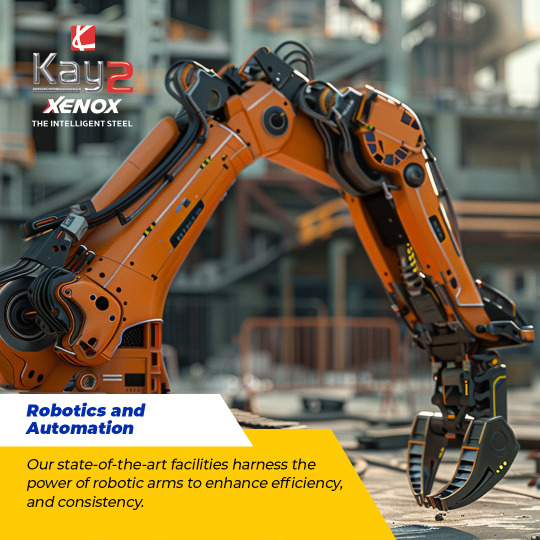#Advanced Construction Technology
Explore tagged Tumblr posts
Text







Experience the convergence of innovation and excellence with Kay2 Xenox. Together, let’s build a brighter, more sustainable tomorrow. for details visit Kay2 Blog
#Advanced Construction Technology#Innovative Steel Solutions#Hexagonal Molecular Bonding#High-Strength TMT Bars#Modern Construction Materials#Cutting-Edge Manufacturing Techniques#High-Rise Construction Safety#kay2 xenox tmt#kay2 steel
0 notes
Text
youtube
The Secrets Behind the Most Advanced Construction Technology
In this video, we will show you the world of advanced construction technology and the groundbreaking innovations The Secrets Behind the Most Advanced Construction Technology that are shaping the future of the industry. In this captivating journey, we dive into cutting-edge technologies and techniques revolutionizing the way we build and construct.
#construction vehicles#advanced construction techniques in civil engineering#advanced building construction techniques#construction methods and techniques#advanced construction techniques#construction techniques in architecture#advanced construction technology#advanced technology construction#advanced technology in construction#advanced building technology#construction tech#virtual design and construction#new construction technology#Youtube
1 note
·
View note
Text
youtube
The Secrets Behind the Most Advanced Construction Technology
In this video, we will show you the world of advanced construction technology and the groundbreaking innovations that are shaping the future of the industry. In this captivating journey, we dive into cutting-edge technologies and techniques revolutionizing the way we build and construct.
#construction vehicles#advanced construction techniques in civil engineering#advanced building construction techniques#construction methods and techniques#advanced construction techniques#construction techniques in architecture#advanced construction technology#advanced technology construction#advanced technology in construction#advanced building technology#construction tech#virtual design and construction#new construction technology#most advanced construction#Youtube
0 notes
Text

Retconned Wardi firearms- a basic handgun, a highly decorative ceremonial handgun (belonging to Faiza), and a lance-gun.
Gun tech has officially been nerfed down to hand cannons (press F) (this has been a long time coming but I'd been fallacy of sunk costs-ing myself out of retconning).
Handguns are held similarly to a shotgun, with the butt pressed into the user's shoulder, one hand gripping under the barrel, and the other free to ignite the gunpowder. These represent the most advanced firearms in contemporary usage, both in make and in their use of uniform iron projectiles built to match the gun's bore for greater range and efficiency. Lance-guns are the more basal form, usually larger and mounted with the pole held over the shoulder, and are most effectively used by two people (one to hold and aim, one to light the gunpowder).
The spread of firearms is currently mostly limited to the Eastern Inner Seaway peoples (with some additional distribution via overland trade), and actual manufacture of hand cannons and gunpowder at Significant scale is limited to the region's core powers.
The reason for this limited spread is partially due to specific elements of the technology's history. Gunpowder was first synthesized by Burri alchemists and considered to be the discovery of the legendary divine weapon + solar fire of the deity Inanariya, and its formula (along with techniques for ideally refining its components) remained a closely guarded state secret. It was used predominantly in priestly contexts to generate flame and explosive sounds (in conjunction with earlier practices of generating multicolored flames with use of other chemicals), then integrated into combustible weaponry in the forms of fire lances, which would eventually develop into early handcannons.
The treatment of gunpowder as a guarded sacred or semi-sacred substance continued with Wardi adoption, where knowledge of its making is considered a closed rite. It's name (inya tsatsul or just tsatsul, a derived adoption of the Burri iñazatsūya) still reflects a divine solar association (the Burri word means 'sun's thunder', the Wardi 'inya' invokes the sun, 'tsatsul' is an adapted loanword and has no meaning independent of the substance itself), though its priestly use is now predominantly associated with the firearm'ed Odonii (rather than priests of the solar Face Inyamache). The composition of gunpowder can no longer be regarded as a Secret by any means, though efforts to obscure the methods of its creation are still moderately successful and has kept knowledge of gunpowder manufacture more limited than the total sphere of firearm usage itself.
The actual strongest limiting factor of firearm usage is the rarity of natural saltpeter deposits necessary for making gunpowder. The practice of actively producing saltpeter via nitraries has not been developed anywhere in the setting, and all is instead obtained via natural sources. These sources are rare and limited within the current spread of firearm technology, and result in gunpowder being a limited and expensive substance to produce. The weapons themselves are also very expensive to manufacture (a good quality steel SWORD is far too material-cost prohibitive for most people to own), particularly high quality firearms designed for use with standardized ammunition.
These guns are also very basal, and logistical difficulties in their use (weight, very slow loading and firing speed, high visibility, Relatively low reach and accuracy) along with the restrictive cost of production has kept firearms far from rendering conventional weaponry, armor, and projectiles obsolete (even within the societies that have access to them). They are still, however, very devastating in use within their contemporary context, particularly in that high quality guns have a longer range than the best arrow-based projectiles, and utterly negate most contemporary forms of armor at close range.
#I'd consider the setting to be like.....most closely analogous to like 3rd-1st century BCE earth (in terms of the average scale of#societies + Most of its technology (aside from major exceptions like this) + trade interconnectivity)#There are VERY few Very Big states capable of mass-manufacturing and resource extraction (like nothing the size of#the Roman empire has Ever existed in this setting. The biggest empires aren't even close. Cynozepal has a pretty massive territorial#span so is probably the closest thing but its actual control is highly fragmented along disconnected central hubs)#There's significant seaway trade connections but the Vast majority of transmission of goods is localized (even moreso over land)#So point being firearms have developed '''''earlier''''''' than in IRL history but the conditions that enabled very rapid spread are#not really present (though it's fairly inevitable that they'll become widespread over the next few centuries)#Also the likely trajectory of adaptation is going to be the development of Plate armor (which could absorb/block shots#from some types of firearms More advanced than these).#The types of armor used in this particular region is mostly lamellar/scale/padded fabric/leather and rarely involves#full body protection (using a shield to compensate) so developing thicker and fully protective armor would be the next logical#step in the arms race#I think it would be a fun constructed history for armor technology to outpace these simple firearms enough that they end up largely#abandoned in favor of re-specializing in close combat but I don't really care to plan out the far future that much
77 notes
·
View notes
Text
youtube
Unveiling Ancient Egypt’s Megalithic Marvels: Secrets of Advanced Engineering
The enigmatic wonders of Ancient Egypt have captivated humanity for centuries. From the towering pyramids to the mysterious Sphinx, these megalithic marvels continue to inspire awe and intrigue. Could these awe-inspiring creations be evidence of advanced ancient technology, or do they hold secrets of a lost civilization?
The Colossal Statues: Titans of Stone
Ancient Egypt’s colossal statues, such as the Great Colossi of Memnon, are feats of artistry and engineering.
Weighing hundreds of tons, these statues were carved with astonishing precision and transported across vast distances.
How could a civilization over 4,000 years ago achieve such monumental feats without modern machinery?
The Pyramids: A Symphony in Stone
The Great Pyramid of Giza is a marvel of architectural mastery, aligned with celestial bodies and featuring flawless geometry.
Some stones used in its construction weigh up to 80 tons, raising questions about ancient construction techniques.
Scholars debate whether these structures were built with rudimentary tools or advanced, forgotten technology.
Transporting Monoliths: Moving Mountains
Ancient Egyptians transported massive stone blocks from quarries to construction sites across rugged terrain.
Theories suggest the use of sledges, ramps, and water-based flotation systems, but definitive answers remain elusive.
Guardians of Eternity: The Enigma of the Sphinx
The Great Sphinx of Giza, with its weathered features and imposing presence, stands as a sentinel to the past.
Some researchers believe it may predate traditional timelines, possibly linked to the Great Flood mentioned in ancient texts.
Its precise craftsmanship and celestial alignment deepen its mystery.
Whispers of the Past: A Lost Civilization?
These remarkable structures might be the legacy of a civilization lost to history.
Evidence points to a cataclysmic event that could have wiped out advanced societies, leaving only fragments of their achievements.
Such theories challenge traditional historical narratives and invite us to rethink humanity’s origins.
Echoes of Grandeur
Ancient Egypt’s megalithic marvels continue to inspire wonder and curiosity.
Whether created through sheer determination or advanced techniques, these structures stand as timeless testaments to human ingenuity.
They remind us of the enduring quest to understand our past and connect with the brilliance of those who came before.
Exploring the mysteries of Ancient Egypt invites us to keep questioning and learning. Share your thoughts on these incredible achievements in the comments below, and join the conversation about the secrets of our shared history.
#ancient egypt#megalithic structures#egyptian pyramids#sphinx mysteries#advanced ancient technology#lost civilization#ancient engineering#great pyramid of giza#colossal statues#egyptian monuments#ancient wonders#ancient egyptian history#archeological discoveries#lost ancient technology#sphinx enigmas#pyramid construction techniques#ancient stone transport#egyptian architecture#ancient history mysteries#advanced engineering marvels#Youtube
3 notes
·
View notes
Text
pvc electric red and blue wire #smartratework#tumblr
#flowers#aesthetic#alternative#grunge#1950s#cute#japan#60s#70s#80s#|| Smart Rate Work#Manufacturing encompasses a diverse array of processes and technologies aimed at producing a wide range of products#from everyday essentials to specialized components. Take wires#for instance: these are typically manufactured through drawing processes#where metal rods or strips are pulled through dies to reduce their diameter and achieve the desired thickness. This method ensures uniformi#crucial for applications in electronics#construction#and industrial settings.#On the other hand#the production of bottles involves molding techniques such as blow molding or injection molding. Blow molding heats plastic resin into a mo#used extensively for beverage containers and packaging. Injection molding#meanwhile#injects molten plastic into a mold under high pressure#ideal for producing intricate shapes with precision#like medical vials or automotive parts.#Both wire and bottle manufacturing rely heavily on materials science#engineering precision#and quality control measures to meet stringent specifications. Advances in automation#robotics#and sustainability practices are transforming these industries
2 notes
·
View notes
Text



#space#futuristic#architecture#ships#dystopian#industrial#cityscape#technology#structures#spacecraft#buildings#clouds#sci-fi city#spaceship fleet#towering skyscrapers#celestial body#colossal structures#advanced civilization#dark atmospheric sci-fi#high-tech urban landscape#multi-level space city#deep space exploration#starship construction site#alien metropolis skyline#ai#ai generated#ai generated images#ai generated tags
2 notes
·
View notes
Text
The Backbone of Construction: A Deep Dive into Construction Equipment
When you pass by a construction site, what catches your eye? It’s not just the towering structures or the bustling workers; it’s the array of heavy machinery and equipment that makes the entire process possible. Construction equipment serves as the backbone of any construction project, enabling the realization of architectural marvels and infrastructural development. In this article, we will take…

View On WordPress
#advanced construction equipment#bulldozers#Construction Equipment#construction equipment automation#construction equipment evolution#construction equipment future#construction equipment safety#construction equipment significance#construction equipment trends#construction equipment types#construction industry#construction machinery#construction site equipment#Construction Technology#construction tools#construction vehicles#cranes#earthmoving equipment#environmental impact#equipment for construction#equipment types#excavators#heavy machinery#material handling equipment#precision machinery#Sustainable Construction
2 notes
·
View notes
Text


The Hulk! (1978) #26
#I actually think that Bruce is a really interesting choice for a story focused on these anti-civilization groups#some of the Hulk’s stories get into man versus nature#and that can be with Bruce representing man and the Hulk representing nature#or it can be with the Hulk versus society#for example there was a short story earlier in this series where an old man was frustrated by how much his hometown had changed#all of the technological advancements and nobody was much paying attention to each other anymore#and then the Hulk came rampaging through because he got upset by the lights and smells and sounds of the city#all the cars and construction and advertisements#but he’s also the only one that’s in tune with his surroundings enough to actually notice the man#and afterwards the old man determines that the Hulk isn’t a monster and has some admiration for him for trashing the street#I think that part of the appeal of the Hulk for some people has been his disconnection from society#he’s appealing because he expresses frustration for or rejects things that those readers believe they just have to put up with#can you imagine the Hulk putting up with an office job?#no he’d do what he’d like which is to smash the office and go off in the woods#there’s a wish-fulfillment element for some people#I can actually also see a throughline between these anti-civilization people’s beliefs#that there will definitely be people out to get them if they don’t arm themselves#and the Hulk’s paranoia that all humans hate him and won’t leave him alone#which is not me saying that I think the Hulk’s worldview is reasonable based on his experiences#and therefore that I think these people's is too#just that I think there’s a lot of potential for further complicating some of the themes that this character has been used for#by critiquing these kinds of people#marvel#bruce banner#my posts#comic panels
2 notes
·
View notes
Text
Exciting Developments in the E-Bike Industry
The E-Bike industry is rapidly evolving, and one brand that stands out is Urtopia. Known for their innovative designs and commitment to sustainability, Urtopia is making waves with their foldable electric bikes. These bikes combine convenience and performance, making them perfect for urban commuting and weekend adventures alike.
Urtopia's foldable electric bikes are not only stylish but also feature advanced technology that enhances the riding experience. With impressive battery life and lightweight construction, these bikes are easy to carry and store, allowing riders to enjoy the freedom of cycling without the hassle of traditional bikes.
As more people embrace eco-friendly transportation options, Urtopia is positioned to lead the charge in the E-Bike market. Their dedication to quality and customer satisfaction is evident, and it's exciting to see how they continue to innovate and inspire.
If you're considering an electric bike, Urtopia's foldable models are definitely worth exploring. Happy riding!
#electric bikes#E-Bike#foldable bikes#eco-friendly transportation#battery life#lightweight construction#urban commuting#advanced technology
1 note
·
View note
Text

Bolts: The Incredible Mechanics Behind Fastener and How They Revolutionized Construction
Bolts Fastener are one of the most simple and ubiquitous fasteners used in construction and mechanical assemblies. At their core, fastener are cylindrical rods with threads on one end that can be tightened or loosened by turning. When fitted through holes and tightened with a nut, fastener securely join two or more components together. Different Types of Bolts There are many varieties of fastener used for different applications. Bolts are commonly used to join metal parts and feature hexagonal heads that can be driven with a wrench. Lag fastener, also called coach screws, have large, cylindrSical heads and sharp threads that allow them to grip into wood or similar materials. Carriage fastener have a rounded head that sits flush and a square shoulder under the head to prevent rotation. Stove fastener are short fastener used to join thin sheets of metal, often found in appliances. Socket head cap screws feature a spherical head that can be driven with a hex key or socket tool. Allen fastener have a hexagonal socket in the head that is tightened with an Allen wrench. Material Composition Fastener are most commonly made of steel or stainless steel. Carbon steel fastener are inexpensive and strong for general construction use. Stainless steel holds up well to corrosion and is commonly used in wet or saltwater environments. Other materials may include brass, aluminum, titanium and specialty alloys depending on the application requirements and operating environment. Higher grades of steel such as alloy steels provide better strength characteristics but at increased cost. The material selection depends on factors like tensile strength needed, operating temperature range, and resistance to corrosion or wear expected. Thread Standards and Specifications Thread standards ensure fastener and nuts from different manufacturers properly interface. Fastener are identified by their diameter, length, thread type, class or grade of material. Common thread standards include unified coarse (UNC), unified fine (UNF), and metric threads. Fastener may have additional specifications for plating, finish, strength class or grade based on standards set by organizations like ASME, SAE, and ISO. Proper specifications ensure fastener reliably provide the clamping force and performance needed for particular engineering applications. Advantages of Bolted Joints There are several advantages that make bolted joints a popular mechanical fastening method: - Versatility - Fastener can join a wide variety of materials and assembly configurations from light fixtures to heavy machinery. - Removability - Bolted connections allow easy disassembly without damaging components for maintenance, repair, or replacement. - Adjustability - Fastener can be tightened or loosened to precisely control clamping force and preload on joints. - Strength - Properly selected and installed fastener provide very high tensile and shear strength for securely joining parts. - Tolerance for error - Bolted joints still function properly despite minor variations in hole alignment or part dimensions. - Economy - Fastener provide strong connections at relatively low cost compared to other joining methods like welding. Fastener in Construction In construction, fastener play a crucial structural role. Anchor fastener secure wooden framing members to concrete or masonry foundations. Lag fastener join beams, joists, and decking to walls or support posts. Machine fastener assembly prefabricated structural members and connect rebar in reinforced concrete slabs and footings. Carriage fastener hold together window and door frames, siding panels, and roofing sheets. Stove fastener install appliance panels and fasten thin gauge sheet metal. Due to their versatility, strength, economy and removability— fastener represent one of the most important innovations that enabled modern construction techniques. Get more insights on, Bolts
For Deeper Insights, Find the Report in the Language that You want.
French
German
Italian
Russian
Japanese
Chinese
Korean
Portuguese
About Author:
Ravina Pandya, Content Writer, has a strong foothold in the market research industry. She specializes in writing well-researched articles from different industries, including food and beverages, information and technology, healthcare, chemical and materials, etc. (https://www.linkedin.com/in/ravina-pandya-1a3984191)
#Full Screw Bolt#Half Screw Bolt#Construction Sector#Automotive Industry#Aerospace Industry#Raw Material Price Volatility#Technological Advancements
0 notes
Text
General English Program, Beginner to Advanced Level English Courses in Melbourne
Orange College offers a General English course in Melbourne CBD, Victoria. Our program will help you develop all the aspects of the English language, such as reading, writing, speaking, listening, grammar, and pronunciation.
#carpentry courses in melbourne for domestic students#carpentry courses in melbourne for international students#carpentry courses melbourne for international students#Beginner to Advanced Level English Courses in Melbourne#certificate iii in cabinet making melbourne#certificate 3 in cabinet making melbourne#Beginner English Courses in Melbourne#Advanced Level English Courses in Melbourne#painting and decorating course melbourne#Advanced English Courses in Melbourne#diploma of leadership and management melbourne for international students#carpentry course melbourne#cabinet maker course melbourne#carpentry course for international students#General English Courses Melbourne#General English Program Melbourne#certificate iii in carpentry course#diploma in leadership and management melbourne#certificate iii in painting and decorating#diploma of leadership and management melbourne#certificate 3 painting and decorating#Certificate III in Cabinet Making and Timber Technology#leadership and management courses melbourne#building and construction courses melbourne#diploma of leadership and management for international students#MSF30322#MSF30322 Cabinet Making#MSF30322 Certificate III in Cabinet Making#carpentry certificate iii course#certificate iv in building and construction
0 notes
Text
Discover the advanced manufacturing processes at Shree TMT that ensure the production of top-tier TMT bars. The company employs state-of-the-art technology and rigorous quality control measures to produce steel that meets the highest industry standards, contributing to safer and more durable infrastructure projects.
#TMT bar manufacturing#steel production#Shree TMT technology#quality control#advanced manufacturing#shreetmt#tmt bars#construction industry#construction materials#construction safety
0 notes
Text
youtube
The Secrets Behind the Most Advanced Construction Technology
In this video, we will show you the world of advanced construction technology and the groundbreaking innovations that are shaping the future of the industry. In this captivating journey, we dive into cutting-edge technologies and techniques revolutionizing the way we build and construct.
#construction vehicles#advanced construction techniques in civil engineering#advanced building construction techniques#construction methods and techniques#advanced construction techniques#construction techniques in architecture#advanced construction technology#advanced technology construction#advanced technology in construction#advanced building technology#construction tech#virtual design and construction#new construction technology#most advanced construction#Youtube
0 notes
Text
What’s the Best Cement for House Construction in 2024?
Choosing the right cement for house construction is crucial for ensuring the strength, durability, and longevity of the structure. With numerous options available, it can be challenging to determine which cement best suits your needs. In 2024, advancements in cement technology have led to the development of superior products that cater to various construction requirements.
0 notes
Text
Study of Use of Bitumen Fiber to Increase Flexural Strength of Concrete_Crimson Publishers

There is sudden increase in blast phenomenon either due to terrorist attack or due to accidents. As a result, security and safety of structure becomes more important and considering blast load in design aspect of structure. One of the ways to increase the concrete strength is to increases the size of the member which will increase the stiffness of the structure and the uplift force below the foundation, but this not only increase the economy but also the factor of limited area will be restrain. This objective of this study is to find the mechanical strength of concrete which can withstand impact and blast loads. In this paper use of use of high-performance concrete is used along with bitumen fiber to give large deformation. Main focus was to increase the ductility of concrete and strong enough to resist blast impact loads without failure. Use of such concrete will considerably affect the economy of the structure by reducing the dimension of the members.
Read more about this article: https://crimsonpublishers.com/acet/fulltext/ACET.000571.php
For more articles in our journal:https://crimsonpublishers.com/acet/
#open journal of civil engineering#advancements in civil engineering & technology#construction#peer reviewed journal of acet#concrete#crimson publishers
0 notes